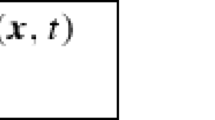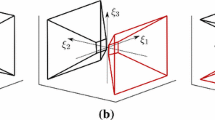Abstract
In the past decades linear scale-space theory was derived on the basis of various axiomatics. In this paper we revisit these axioms and show that they merely coincide with the following physical principles, namely that the image domain is a Galilean space, that the total energy exchange between a region and its surrounding is preserved under linear filtering and that the physical observables should be invariant under the group of similarity transformations. These observables are elements of the similarity jet spanned by natural coordinates and differential energies read out by a vision system.
Furthermore, linear scale-space theory is extended to spatio-temporal images on bounded and curved domains. Our theory permits a delay-operation at the present moment which is in agreement with the motion detection model of Reichardt. In this respect our theory deviates from that of Koenderink which requires additional syntactical operators to realise such a delay-operation.
Finally, the semi-discrete and discrete linear scale-space theories are derived by discretising the continuous theories following the theory of stochastic processes. The relation and difference between our stochastic approach and that of Lindeberg is pointed out. The connection between continuous and (semi-)discrete sale-space theory for infinitely high scales observed by Lindeberg is refined by applying appropriate scaling limits. It is shown that Lindeberg's requirement of normalisation for one-dimensional discrete Green's functions can be incorporated into our theory for arbitrary dimensional discrete Green's functions, parameter determination can be avoided, and the requirement of operation at even and odd coordinates sum can be guaranteed simultaneously by taking a normalised linear combination of the identity operator and the first step discrete Green's functions. The new discrete Green's functions are still intimately related to the continuous Green's functions and appear to coincide with pyramidal discrete Green's functions.
Similar content being viewed by others
References
L. Alvarez and J. M. Morel, “Formalization and computational aspect of image analysis,” Acta Numerica, pp. 1–63, 1994.
J. Babaud, A. P. Witkin, M. Baudin and R. O. Duda, “Uniqueness of the Gaussian kernel for scale-space filtering,” IEEE Trans. Pattern Analysis and Machine Intelligence, Vol. 8, pp. 26–33, 1986.
G. W. Bluman and J. D. Cole, Similarity Methods for Differential Equations, Springer-Verlag: New York, 1974.
J. L. Crowley, A Representation for Visual Information, PhD thesis, Carnegie-Mellon University, Robotics Institute, Pittsburgh, Pennsylvania, 1981.
R. Deriche, “Fast algorithms for low-level vision,” IEEE Trans. Pattern Analysis and Machine Intelligence, Vol. 12, pp. 78–87, 1990.
D. Eberly, “A differential geometric approach to anisotropic diffusion,” In Geometry-Driven Diffusion in Computer Vision, Kluwer Academic Publishers: Dordrecht, 1994, pp. 371–392.
D. Eberly, Geometric Analysis of Ridges in N-Dimensional Images, PhD thesis, University of North Carolina, Department of Computer Vision, Chapel Hill, North Carolina, 1994.
S. D. Eidel'Man, Parabolic Systems, North-Holland Publishing Company andWolters-Noordhoff Publishing: Amsterdam, 1962.
L. M. J. Florack, The Syntactical Structure of Scalar Images, PhD thesis, Utrecht University, Department of Medicine, Utrecht, the Netherlands, 1993.
L. M. J. Florack, B. M. ter Haar Romeny, J. J. Koenderink and M. A. Viergever, “Images: Regular tempered distributions,” In Proc. of the NATO Advanced Research Workshop Shape in Picture-Mathematical description of shape in grey-level images, Vol. 126 of NATO ASI Series F, Springer Verlag: Driebergen, the Netherlands, 1994, pp. 651–660.
A. Friedman, Partial Differential Equations of the Parabolic Type, Prentice-Hall, 1964.
H. J. A. M. Heijmans, “Mathematical morphology: a geometrical approach in image processing,” Nieuw Archief voor Wiskunde, Vol. 10, pp. 237–276, 1992.
R. A. Hummel, “The scale-space formulation of pyramid data structures,” In Parallel Computer Vision, Academic Press: New York, 1987, pp. 187–123.
T. Iijima, “Basic theory on the normalization of a pattern,” Bulletin of Electrical Laboratory, Vol. 26, pp. 368–388, 1962.
J. D. Jackson, Classical Electrodynamics, John Wiley & Sons, Inc., 1962.
P. Johansen, “On the classification of top-points in scale-space,” Journal of Mathematical Imaging and Vision, Vol. 4, pp. 57–68, 1994.
J.-J. Jolion and A. Rozenfeld, A Pyramid Framework for Early Vision, Kluwer Academic Publishers: Dordrecht, the Netherlands, 1994.
S. N. Kalitzin, B. M. ter Haar Romeny, A. H. Salden, P. F. M. Nacken and M. A. Viergever, “Topological numbers and singularities in scalar images; scale-space evolution properties,” accepted for publication in Journal of Mathematical Imaging and Vision, 1996.
G. Kin and M. Sato, “Scale space filtering on spherical pattern,” In Proceedings 11th IAPR Internat. Conf. on Pattern Recognition, The Hague, the Netherlands, 1992, pp. 638–641.
F Klein, Vorlesungen Über Nicht-Euclidische Geometrie, Vol. XXVI, Verlag von Julius Springer: Berlin, 1928.
J. J. Koenderink, “The structure of images,” Biol. Cybern., Vol. 50, pp. 363–370, 1984.
J. J. Koenderink, “Scale-time,” Biol. Cybern., Vol. 58, pp. 159–162, 1988.
J. J. Koenderink and A. J. van Doorn, “A description of the structure of visual images in terms of an ordered hierarchy of light and dark blobs,” In Second Int. Visual Psychophysics and Medical Imaging Conf., IEEE Cat. No. 81 CH 1676-6, 1981.
J. J. Koenderink and A. J. van Doorn, “Representation of local geometry in the visual system,” Biol. Cybern., Vol. 55, pp. 367–375, 1987.
J. J. Koenderink and A. J. van Doorn, “Generic neighborhood operators,” IEEE Trans. Pattern Analysis and Machine Intelligence, Vol. 14, pp. 597–605, 1992.
L. M. Lifshitz and S. M. Pizer, “A multiresolution hierarchical approach to image segmentation based on intensity extrema,” IEEE Trans. Pattern Analysis and Machine Intelligence, Vol. 12, pp. 529–541, 1990.
T. Lindeberg, “On scale selection for differential operators,” In Proc. 8th Scandinavian Conf. Image Analysis, Trömso, Norway, 1993, pp. 857–866.
T. Lindeberg, “Scale-space for N-dimensional discrete signals,” In Proc. of the NATO Advanced Research Workshop Shape in Picture-Mathematical description of shape in grey level images, Vol. 126 of NATO ASI Series F, Springer Verlag: Driebergen, the Netherlands, 1994, pp. 651–660.
T. Lindeberg, Scale-Space Theory in Computer Vision, The Kluwer International Series in Engineering and Computer Science, Kluwer Academic Publishers, Dordrecht, the Netherlands, 1994.
T. Lindeberg, “On the Axiomatic Foundations of Linear Scale-Space,” In Gaussian Scale-Space Theory, Computational Imaging and Vision, Kluwer Academic Publishers: Dordrecht, the Netherlands, 1996.
T. Lindeberg, “Linear spatio-temporal scale-space,” In Scale-Space 97, First International Conference on Scale-Space Theory in Computer Vision, Utrecht, the Netherlands, 1997, pp. 113–127.
T. Lindeberg and J. O. Eklundh, “On the computation of a scale-space primal sketch,” Journal of Visual Comm. and Image Rep., Vol. 2, pp. 55–78, 1991.
T. Lindeberg and D. Fagerstrom, “Scale-space with causal time direction,” In Proc. 4th European Conference on Computer Vision, Vol. 1064 of LNCS, pp. 229–240, 1996.
T. Lindeberg and L. M. J. Florack, “Foveal scale-space and linear increase of receptive field size as a function of eccentricity,” Technical Report ISRN KTH/NA/P–94/27–SE, Dept. of Numerical Analysis and Computing Science, Royal Institute of Technology, 1994.
M. Nielsen, “Scale-space generators and functionals,” In Gaussian Scale-Space Theory, Computational Imaging and Vision, Kluwer Academic Publishers: Dordrecht, the Netherlands, 1996.
M. Nielsen, W. Niessen, R. Maas, L. M. J. Florack and B. M. ter Haar Romeny, “On the duality of scalar and density flows,” In Scale-Space 97, First International Conference on Scale-Space Theory in Computer Vision, Utrecht, the Netherlands, 1997, pp. 65–76.
P. J. Olver, Applications of Lie Groups to Differential Equations, Vol. 107 of Graduate Texts in Mathematics, Springer-Verlag: Berlin, 1986.
E. Parzen, Modern Probability Theory and Its Applications, Wiley: New York, 1960.
E. J. Pauwels, P. Fiddelaers, T. Moons and L. J. van Gool, “An extended class of scale-invariant and recursive scale-space filters,” IEEE Trans. Pattern Analysis and Machine Intelligence, Vol. 12, pp. 629–639, 1995.
G. F. Poggio and W. Reichardt, “Considerations on models of movements detection,” Kybernetik, Vol. 13, pp. 223–227, 1973.
L. C. G. Rogers and D. Williams, Diffusions, Markov Processes and Martingales, Vol. 1–2, John Wiley & Sons, 1986.
M. Rosenblatt, Markov Processes. Structure and Asymptotic Behaviour, Vol. 184 of Die Grundlehren der mathematischen Wissenschaften in Einzeldarstellungen, Springer-Verlag: Berlin, 1971.
A. H. Salden, Dynamic Scale-Space Paradigms, PhD thesis, Utrecht University, Department of Medicine, Utrecht, the Netherlands, 1996.
A. H. Salden, “Invariant theory,” In Gaussian Scale-Space Theory, Computational Imaging and Vision, Kluwer Academic Publishers: Dordrecht, the Netherlands, 1996.
A. H. Salden, L. M. J. Florack, B. M. ter Haar Romeny, M. A. Viergever and J. J. Koenderink, “The nonlinear rescaling process,” Technical report 3DCV 92-28, Utrecht University, Utrecht, the Netherlands, 1992.
A. H. Salden, B. M. ter Haar Romeny and M. A. Viergever, “Modern geometry and dynamic scale-space theories,” In Proc. Conf. on Differential Geometry and Computer Vision: From Pure over Applicable to Applied Differential Geometry, Nordfjordeid, Norway, 1995.
A. H. Salden, B. M. ter Haar Romeny and M. A. Viergever, “Differential and integral geometry of linear scale spaces,” Journal of Mathematical Imaging and Vision, Vol. 9, pp. 5-27, 1998.
A. H. Salden, B. M. ter Haar Romeny, and M. A. Viergever, “Dynamic scale-space theories,” In Scale-Space 97, First International Conference on Scale-Space Theory in Computer Vision, Utrecht, the Netherlands, 1997, pp. 248–259.
C. Schmidt and R. Mohr, “Combining grey-value invariants with local constraints for object recognition,” In Proc. Intern. Conf. on Computer Vision and Pattern Recognition CVPR, San Francisco, USA, 1996.
J. Segman and W. Schempp, “Two ways to incorporate scale in the Heisenberg group with an intertwining operator,” Journal of Mathematical Imaging and Vision, Vol. 3, pp. 79–94, 1993.
J. Segman and Y. Y. Zeevi, “Image analysis by wavelet-type transforms: Group theoretic approach,” Journal of Mathematical Imaging and Vision, Vol. 3, pp. 51–77, 1993.
M. R. Spiegel, Theory and Problems of Complex Variables with an introduction to Conformal Mappings and its applications, McGraw-Hill Book Company, 1964.
M. Spivak, Differential Geometry, Vol. 1–5, Publish or Perish, Inc.: Berkeley, California, USA, 1975.
B. M. ter Haar Romeny, Geometry-Driven Diffusion in Computer Vision, Kluwer Academic Publishers: Dordrecht, 1994.
R. van den Boomgaard, Mathematical Morphology: Extensions towards Computer Vision, PhD thesis, University of Amsterdam, Amsterdam, the Netherlands, 1992.
J. Weickert, S. Ishikawa and A. Imiya, “On the History of Gaussian Scale-Space Axiomatics,” In Gaussian Scale-Space Theory, Kluwer Academic Publishers: Dordrecht, 1996, pp. 45–59.
A. P. Witkin, “Scale-space filtering,” In Proc. International Joint Conference on Artificial Intelligence, Karlsruhe, Germany, 1983, pp. 1019–1023.
Author information
Authors and Affiliations
Rights and permissions
About this article
Cite this article
Salden, A.H., ter Haar Romeny, B.M. & Viergever, M.A. Linear Scale-Space Theory from Physical Principles. Journal of Mathematical Imaging and Vision 9, 103–139 (1998). https://doi.org/10.1023/A:1008300826001
Issue Date:
DOI: https://doi.org/10.1023/A:1008300826001




